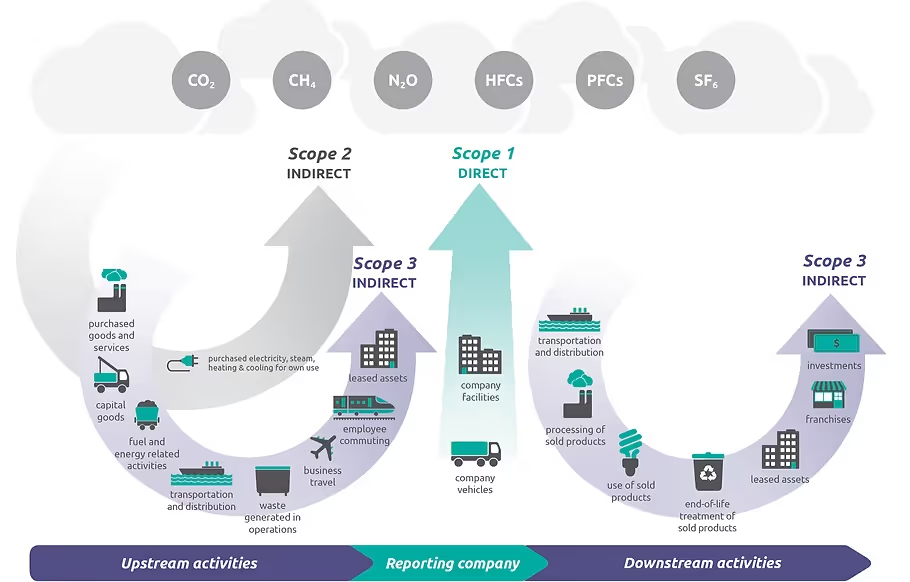
Solutions
Carbon Management
ESG Intelligence
Climate & Nature Risk
Data Registry
Beta
Sector
Get started, schedule a demo or request a free assessment!


Scope 3 emissions are all indirect emissions that occur in the value chain of a company and those that are not already included within Scopes 1 and 2. Scope 3 emissions include all sources external to a company's scope 1 and 2 boundaries. Scope 3 emissions result from activities outside the operational control of the company. These emissions are also called value chain emissions and typically comprise the largest portion of a company's total greenhouse gas (GHG) emissions.
Scope 3 emissions are broken down into 15 categories and subdivided into upstream and downstream emissions within the value chain to offer a systematic framework for understanding, measuring, and reporting.
Upstream emissions: These emissions occur before a company's products or services are created. These are emissions generated along the production and supply chain of goods and services prior to reaching your final consumer. For instance, emissions associated with the transportation of raw materials from the supplier factory to your company’s factory by a logistics service provider or the emissions associated with the product of the input raw material used in your company’s manufacturing process would all be considered upstream emissions
Downstream emissions: These emissions occur after a company's products or services are produced or sold. These are emissions generated outside your company’s production boundary including after your product or service reaches your final consumer. For example, the emissions from transporting a product to a customer the emissions associated with the end-of-life disposal of a product, or any emissions occurring due to additional processing by a customer of your sold product would all be considered downstream emissions.

Scope 3 emissions are essentially another organization’s Scope 1 and/or Scope 2 emissions. For example, for the logistics provider transporting your company’s raw materials from the supplier factory to your factory, their company is buying and burning diesel in their trucks which is their Scope 1 emissions. For your company, these emissions will be accounted for in your Scope 3. As another example, a power company producing electricity from coal will have significant Scope 1 emissions which for the raw material supplier mentioned above will be their Scope 2 emissions, which in turn would be Scope 3 emissions for your company.
There are various reasons for your organization to measure its Scope 3 Emissions including having a comprehensive understanding of your organization’s overall environmental impact, improving your supply chain management, improving reputation and investor confidence, complying with regulatory requirements, mitigating risks and cost savings, and to make informed decisions
Scope 3 emissions are more often than not, much greater than a company's Scope 1 and 2 emissions. Therefore, Scope 3 emission measurement is needed to provide a more holistic understanding of your organization’s environmental impact across the supply chain. This comprehensive view is essential for you to set realistic emissions reduction targets and make informed decisions.
By understanding your organization’s Scope 3 emissions profile, you and your team can make informed decisions about product design, sourcing strategies, and logistics operations. This data can provide insights and drive innovation in sustainable product development, resource efficiency, and alternative procurement transportation choices.
An increasing number of regulations and reporting standards, including Business Responsibility and Sustainability Reporting (BRSR) in India, Carbon Disclosure Project (CDP), and European Sustainability Reporting Standards (ESRS), mandate or encourage companies to disclose their Scope 3 emissions. Measuring and reporting these emissions helps companies stay ahead of regulatory changes and avoid potential penalties.
Greenhouse Gas Protocol (GHG Protocol) Corporate Value Chain (Scope 3) Accounting and Reporting Standard is the globally recognized standard for measuring and reporting Scope 3 emissions. Each major reporting framework like
Business Responsibility and Sustainability Report (BRSR) in India, Global Reporting Initiative (GRI), Carbon Disclosure Project (CDP), Task Force on Climate-related Financial Disclosures (TCFD), Taskforce on Nature-related Financial Disclosures (TNFD), Integrated Reporting Framework (IR) European Sustainability Reporting Standards (ESRS) provide guidance on their Scope 3 reporting requirements based on factors such as company size, market cap, sector of operation among others.
Your organization can also choose to take advantage of software-as-a-service (SaaS) solutions that streamline the entire process of tracking, measuring, analyzing, and reporting GHG emissions data. StepChange is one of the leading platforms that enables organizations to identify, measure, analyze, and report their Scope 1, 2, and 3 emissions in standardized frameworks and comes with a user-friendly and powerful dashboard to help derive meaningful insights to work toward emissions reduction.
With StepChange, organizations can gain valuable insights into their supply chain emissions, set and track progress toward reduction targets, and accelerate their sustainability journey.
Let us know if you want support in calculating and reporting your GHG Emissions

.svg)